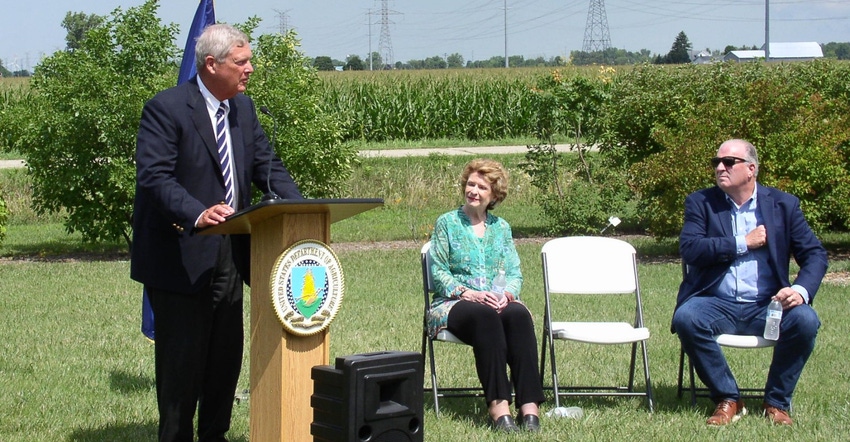
On Monday, Agriculture Secretary Tom Vilsack traveled to Michigan, where he joined Senate Agriculture Committee Chairwoman Debbie Stabenow, D-Mich., and Rep. Dan Kildee, D-Mich., to announce the new efforts to help farmers increase their bottom line while producing the world’s food and to highlight the Biden administration’s efforts to promote climate smart practices and support nutrient management strategies.
USDA says the new conservation funding in the Inflation Reduction Action, along with actions taken to streamline USDA conservation programs, will bolster the steps that USDA’s Natural Resources Conservation Service announced to improve opportunities for nutrient management.
“The pandemic and Ukraine invasion have led to supply chain disruptions, higher prices of inputs, and goods shortages in countries across the globe,” says Vilsack. “USDA is responding to the needs of U.S. producers and consumers by adding program flexibilities, expanding options and assistance, and investing in nutrient management strategies to help farmers address local resource concerns and global food security while also improving their bottom line.”
While speaking in Michigan, Vilsack notes that farmers continue to find themselves facing higher input costs. He notes that 28% of all farmland in the country over-fertilizes. “We’re seeing high levels of nitrogen which in turn creates issues with water quality in places like the Great Lakes,” Vilsack says. “If we can equip farmers with the ability to reduce the level and to better manage the nutrients and the application of those nutrients on that 28% of our land, we will save them money. We will ensure productivity. We will improve soil health. And we will improve water quality.”
Vilsack says the targeted efforts help educate farmers about the 4Rs - right rate, right time, right product and right location in nutrient use. "We want to equip farmers with the ability to essentially do right by their land with better nutrient management," he says with the jump start of funds for NRCS.
When asked about how quickly the funding will help solve some of the greatest problems from the wrong approach to nutrients, Vilsack admits it won’t happen overnight.
“We didn’t get into this situation overnight. We’re not going to get out of it overnight,” he says. “The goal here though is consistency and consistent investment and significant investment. I’m confident we’re going to have that consistent investment because now we’re offering farmers the ability to reduce their costs.”
NRCS efforts to improve nutrient management
NRCS will target funding, increase program flexibilities, launch a new outreach campaign to promote nutrient management’s economic benefits, in addition to expanding partnerships to develop nutrient management plans. This is part of USDA’s broader effort to address future fertilizer availability and cost challenges for U.S. producers, according to a statement from USDA.
Through USDA’s conservation programs, farmers and ranchers will have streamlined opportunities to improve their nutrient management planning, which provides conservation benefits while mitigating the impacts of supply chain disruptions and increased input costs.
Specifically, NRCS efforts include:
Streamlined Nutrient Management Initiative – A streamlined imitative will incentivize nutrient management activities through key conservation programs, including the Environmental Quality Incentives Program, EQIP Conservation Incentive Contracts, and the Conservation Stewardship Program. The initiative will use a ranking threshold for pre-approval and include a streamlined and expedited application process, targeted outreach to small-scale and historically underserved producers, and coordination with FSA to streamline the program eligibility process for producers new to USDA.
In addition to otherwise available funding at the state level, NRCS is targeting additional FY23 funds for nutrient management. NRCS is also announcing a streamlined funding opportunity for up to $40 million in nutrient management grant opportunities through the Regional Conservation Partnership Program.
Vilsack explains the $40 million will also be combined with additional resources when the new budget year begins October 1 with additional resources from the EQIP program and contract incentives in CSP to allow for farmers to do an “even better job of nutrient management.”
Nutrient Management Economic Benefits Outreach Campaign – A new outreach campaign will highlight the economic benefits of nutrient management planning for farmers. The potential net savings to farmers who adopt a nutrient management plan is estimated to be an average of $30 per acre for cropland. It is estimated that there are 89 million acres of cropland (28% of total U.S. cropland) currently exceeding the nitrogen loss threshold; and if all those acres implemented a nutrient management plan, the average net savings would be $2.6 billion.
NRCS staff develop nutrient management plans to help producers use nutrient resources effectively and efficiently to adequately supply soils and plants with necessary nutrients while minimizing transport of nutrients to ground and surface waters. Producer information is available at farmers.gov/global-food-insecurity.
Expanded Nutrient Management Support through Technical Service Providers Streamlining and Pilots – New agreements with key partners who have existing capacity to support nutrient management planning and technical assistance will expand benefits and serve as a model to continue streamlining the certification process for Technical Service Providers. NRCS is also developing new opportunities to support partner training frameworks, nutrient management outreach and education, and new incentive payments through TSP partners for nutrient management planning and implementation.
“We are going to expand the number of technical service providers by making it easier with less paperwork and more quickly getting certified so that we can have more people on the ground helping those farmers utilizing the program,” Vilsack explains.
About the Author(s)
You May Also Like






